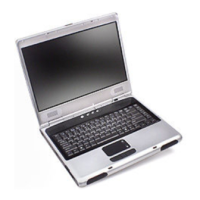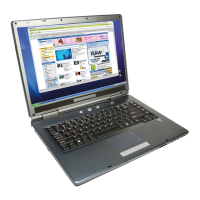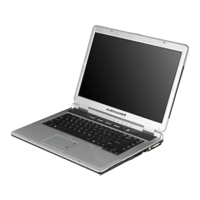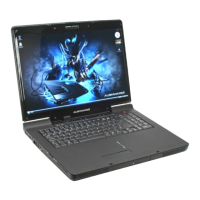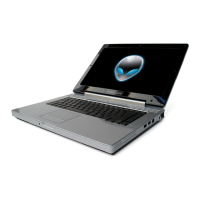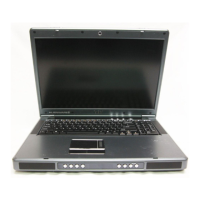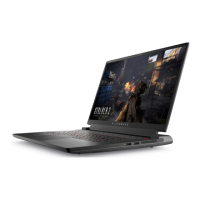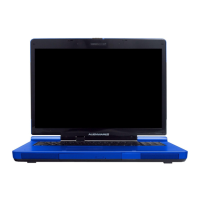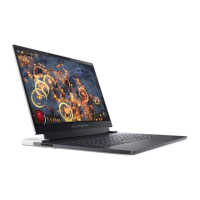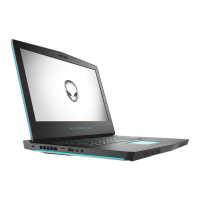Do you have a question about the Alienware Area-51m and is the answer not in the manual?
Steps to prepare the computer before internal component disassembly.
Guidelines and procedures for protecting electronic components from ESD damage.
Safe practices and guidelines for lifting heavy computer equipment.
Safety guidelines and precautions when handling the lithium-ion battery.
Steps to remove an M.2 2230 solid-state drive.
Steps to remove an M.2 2280 solid-state drive or Intel Optane storage.
Steps to replace an M.2 2230 solid-state drive.
Steps to replace an M.2 2280 solid-state drive or Intel Optane storage.
How to check and install Intel chipset drivers.
How to check and install video drivers.
How to check and install Intel Serial IO drivers.
How to check and install Intel Trusted Execution Engine Interface drivers.
How to check and install wireless and Bluetooth drivers.
Steps to access the BIOS setup utility.
How to configure the boot sequence for devices.
Overview of available system configuration settings.
Steps to update the BIOS through the Dell support website.
Overview of the ePSA diagnostic program for hardware testing.
Steps to prepare the computer before internal component disassembly.
Guidelines and procedures for protecting electronic components from ESD damage.
Safe practices and guidelines for lifting heavy computer equipment.
Safety guidelines and precautions when handling the lithium-ion battery.
Steps to remove an M.2 2230 solid-state drive.
Steps to remove an M.2 2280 solid-state drive or Intel Optane storage.
Steps to replace an M.2 2230 solid-state drive.
Steps to replace an M.2 2280 solid-state drive or Intel Optane storage.
How to check and install Intel chipset drivers.
How to check and install video drivers.
How to check and install Intel Serial IO drivers.
How to check and install Intel Trusted Execution Engine Interface drivers.
How to check and install wireless and Bluetooth drivers.
Steps to access the BIOS setup utility.
How to configure the boot sequence for devices.
Overview of available system configuration settings.
Steps to update the BIOS through the Dell support website.
Overview of the ePSA diagnostic program for hardware testing.
| Form factor | Clamshell |
|---|---|
| Product type | Laptop |
| Product color | Black |
| Market positioning | Gaming |
| Pixel pitch | 0.1989 x 0.1989 mm |
| LED backlight | Yes |
| Pixel density | 127 ppi |
| Display surface | Matt |
| Display diagonal | 17.3 \ |
| Display brightness | 300 cd/m² |
| Native aspect ratio | 16:9 |
| Maximum refresh rate | 60 Hz |
| Memory slots | 4x SO-DIMM |
| Internal memory | 16 GB |
| Memory clock speed | 2400 MHz |
| Memory form factor | SO-DIMM |
| Internal memory type | DDR4-SDRAM |
| Maximum internal memory | 64 GB |
| Memory layout (slots x size) | 2 x 8 GB |
| HDD size | 2.5 \ |
| Storage media | Hybrid-HDD |
| Total storage capacity | 1000 GB |
| Hybrid-HDD cache memory | 8 GB |
| Speaker power | 8 W |
| Front camera HD type | HD |
| Video capturing speed | 30 fps |
| Front camera resolution | 1280 x 720 pixels |
| Front camera signal format | 720p |
| Front camera resolution (numeric) | 0.92 MP |
| Antenna type | 2x2 |
| Bluetooth version | 5.0 |
| Top Wi-Fi standard | Wi-Fi 6 (802.11ax) |
| WLAN controller model | Killer Wireless-AX 1650 |
| Ethernet LAN data rates | 10, 100, 1000, 2500 Mbit/s |
| Charging port type | DC-in jack |
| USB 2.0 ports quantity | 0 |
| Ethernet LAN (RJ-45) ports | 1 |
| USB 3.2 Gen 1 (3.1 Gen 1) Type-A ports quantity | 3 |
| Pointing device | Touchpad |
| Keyboard backlit color | Various |
| Scalability | 1S |
| Processor ARK ID | 191792 |
| Processor package size | 37.5 x 37.5 mm |
| Supported instruction sets | SSE4.1, SSE4.2, AVX 2.0 |
| Thermal solution specification | PCG 2015C |
| Battery weight | 370 g |
| Battery voltage | 11.4 V |
| Battery capacity | 90 Wh |
| Battery recharge time | 4 h |
| Number of battery cells | 6 |
| Operating shock | 140 G |
| Operating altitude | 0 - 3048 m |
| Non-operating shock | 160 G |
| Operating vibration | 0.66 G |
| Non-operating altitude | 0 - 10668 m |
| Non-operating vibration | 1.3 G |
| Storage temperature (T-T) | -40 - 65 °C |
| Operating temperature (T-T) | 0 - 40 °C |
| Storage relative humidity (H-H) | 0 - 95 % |
| Operating relative humidity (H-H) | 10 - 90 % |
| AC adapter frequency | 50 - 60 Hz |
| AC adapter input voltage | 100 - 240 V |
| AC adapter output voltage | 19.5 V |
| Tjunction | 100 °C |
| Processor cache | 12 MB |
| Processor cores | 8 |
| Processor model | i7-9700 |
| System bus rate | 8 GT/s |
| Processor family | Intel® Core™ i7 |
| Processor socket | LGA 1151 (Socket H4) |
| Processor codename | Coffee Lake |
| Processor frequency | 3 GHz |
| Processor cache type | Smart Cache |
| Processor lithography | 14 nm |
| Processor manufacturer | Intel |
| PCI Express slots version | 3.0 |
| Processor boost frequency | 4.7 GHz |
| Processor operating modes | 64-bit |
| PCI Express configurations | 1x16, 2x8, 1x8+2x4 |
| Thermal Design Power (TDP) | 65 W |
| Maximum number of PCI Express lanes | 16 |
| CUDA cores | 1920 |
| On-board graphics card ID | 0x3E98 |
| Discrete graphics card model | NVIDIA® GeForce RTX™ 2060 |
| On-board graphics card model | Intel® UHD Graphics 630 |
| Discrete graphics card memory | 6 GB |
| Discrete graphics memory type | GDDR6 |
| On-board graphics card OpenGL version | 4.5 |
| On-board graphics card base frequency | 350 MHz |
| On-board graphics card DirectX version | 12.0 |
| On-board graphics card dynamic frequency (max) | 1200 MHz |
| Depth | 319.14 mm |
|---|---|
| Width | 402.6 mm |
| Weight | 3870 g |
| Height (rear) | 31.2 mm |
| Height (front) | 27.65 mm |
